 Gospel of 22 July 2020
Gospel of 22 July 2020
Feast of St Mary Magdalene
John 20:1-2,11-18
'Mary, go and find the brothers and tell them'
It was very early on the first day of the week and still dark, when Mary of Magdala came to the tomb. She saw that the stone had been moved away from the tomb and came running to Simon Peter and the other disciple, the one Jesus loved. ‘They have taken the Lord out of the tomb’ she said ‘and we don’t know where they have put him.’
Meanwhile Mary stayed outside near the tomb, weeping. Then, still weeping, she stooped to look inside, and saw two angels in white sitting where the body of Jesus had been, one at the head, the other at the feet. They said, ‘Woman, why are you weeping?’ ‘They have taken my Lord away’ she replied ‘and I don’t know where they have put him.’ As she said this she turned round and saw Jesus standing there, though she did not recognise him. Jesus said, ‘Woman, why are you weeping? Who are you looking for?’ Supposing him to be the gardener, she said, ‘Sir, if you have taken him away, tell me where you have put him, and I will go and remove him.’ Jesus said, ‘Mary!’ She knew him then and said to him in Hebrew, ‘Rabbuni!’ – which means Master. Jesus said to her, ‘Do not cling to me, because I have not yet ascended to the Father. But go and find the brothers, and tell them: I am ascending to my Father and your Father, to my God and your God.’ So Mary of Magdala went and told the disciples that she had seen the Lord and that he had said these things to her.
Reflexion
St Mary Magdalene is a popular figure among modern folks. She has been subjected to revisionist story telling that depicts her as a secret lover of Christ, a wife of the Messiah, and lastly as a midwife in a little known movie that was released last year.
Perhaps, the shock value that these Hollywood revisionist narratives wish to push forward is this image of her as the feminist ideal: a strong, independent, intelligent woman who has been emancipated from a cruel patriarchy. I believe that these movie directors and script writers, in rewriting the story hope to redeem Mary from the traditional image of her being a prostitute. I’ll come to that soon. But they fail to realise that when a theme is repeated so often, the ridiculous story-line loses its shock value and becomes boring.
So how did Mary of Magdala become a prostitute? The short answer is that, since the time of Pope St Gregory the Great and perhaps even earlier, Mary Magdalene is often associated with several women mentioned in the Bible. First, she is identified with the woman of ill repute in Chapter 7 of Luke’s gospel, who bathes Jesus’ feet with her tears, anoints them with ointment from her alabaster jar, and dries them with her hair. Since this action seems to have been repeated by Mary of Bethany, the sister of Lazarus and Martha, in Chapter 12 of John’s Gospel, Mary of Magdala is also identified as Mary of Bethany. The Church has a feast dedicated to the memory of St Martha but none to St Mary of Bethany, because according to tradition, Mary of Bethany is Mary of Magdala.
The conflation of Mary of Bethany and Mary of Magdala results not just from their shared name but also from the presence of the alabaster jar of perfumed oil. This jar is the main clue that points to Mary’s most important role in the gospels and the reason why we celebrate her feast as equal in rank with those of the Apostles. Mary of Magdala was among the women who brought jars of perfumed oil to the tomb to anoint Jesus’ body. That’s it - Mary’s greatest role was that she was an essential and primary witness of the resurrection, the bedrock of the Christian Faith.
All four gospels agree that Mary Magdalene was present at the empty tomb on Easter Sunday. But according to the Gospel of St John, Mary is the first person to whom Jesus chose to reveal Himself. She is also the first one to bring good news of the empty tomb to the apostles: Mary Magdalene was prima inter apostolos, apostle to the Apostles. For this reason, we can safely say that our whole Christianity depended on her testimony. In the 2019 movie named after her, she is depicted as a midwife, an interesting twist to the story, though not one based on tradition or found in scriptures. But even if this was true, not only was she a midwife to the young mothers of Magdala, she also midwifed Christianity.
No injustice is done to Mary when tradition conflates her with the sinful woman and Mary of Bethany. Rather we see in this conflated story-line, the wonder of conversion and the power of grace at work in her. St. Mary Magdalene, the repentant sinner, who found both forgiveness and friendship with our Lord, who stood faithfully at the foot of the cross, and who saw the risen Lord, is a powerful example for each of us.
What greater honour could the Church grant than by recognising Mary Magdalene as a saint, an apostle to the Apostles and a model for every sincere Christian who struggles for holiness? Pope St. Gregory realised Mary Magdalene’s beautiful example: a woman who found new life in Christ, not a woman who found a self-empowered political agenda. Frankly, if we wish to do justice to her memory, more people ought to spend their time reading the Bible, reading about the fathers of the Church and the Catechism instead of watching such bogus rubbish that is spun by the likes of Hollywood.
